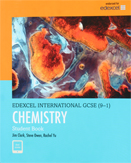|
Chemguide Support for |
|

Support for home-schooling parents Have I got the right book? First, make sure that we are talking about the right book. This is the book you need to be using if your son or daughter is doing their exam in June 2019 or later. If they are doing their exam before that, you should be looking at the previous version of the book. Follow this link for the pages relating to the older book. Can the older book still be used for the current syllabus? Well . . . If you were an experienced chemistry teacher with a good knowledge of the differences between the new and old syllabuses, you could use it, but it would be a bit of a pain. If you are none of those things, then use this new book, which is specifically designed for the new syllabus, and where you can be sure that the examiners are happy that the book accurately reflects the contents of the syllabus. Can we just work through the new book starting from page 1? You could for the most part, but if you have read the page briefly describing the book, you will remember that the book is written in syllabus order. That isn't necessarily an ideal teaching order. The main problem is that the syllabus introduces chemistry calculations very early on - in this book, they start to appear in chapters 5 and 6 (in the older book, they occupied the final chapters 22 - 26). Many students find these either difficult or boring, and my preference is to leave them until the end of the course when they have built up confidence. In a school situation, teachers can, of course, teach the material in any order they choose. Doing calculations early on also means that you are constantly having to refer to reactions that students aren't yet familiar with. My strong recommendation is that (unless your son or daughter loves maths) you leave all the calculations that you come across until the very end. But don't forget to make a note of every single page that you have missed out on the first run through the book so that you cover it all by the end of the course. What if I can't follow something in the book, or I disagree with an answer? I wrote the original (older) book with an eye on the needs of home-schooling parents with little or no chemistry, but have had no part at all in the conversion into the new one. The old one was designed to be followed by someone with little or no chemistry, and I hope the new one will prove to be the same. If you find something that you don't understand, or if you think there may be a wrong answer, please contact me via the address on the about this site page of Chemguide so that I can try to sort it out. If necessary, I can add any additional explanations to this web page (or a link from this page) so that everybody can benefit. Please don't feel embarrassed in asking about things you don't understand, or pointing out problems to me. When I was teaching, I worked on the principle that my students had a right to understand things and, provided they weren't just day-dreaming, if they didn't understand something I taught them, it was my fault and not theirs. I still believe that. Can I make clear, though, that this service only applies to home-schooling parents (or teachers finding problems with the answers), and not to students themselves. I don't have the time or energy to serve as a personal tutor to thousands and thousands of individual students! (Chemguide as a whole is currently getting over two million visits a month (2017) - there is no way that I can cope with students asking me questions!) Where can I find answers to the questions in the book? You will currently find these on the Pearson website at the end of the eBook (follow the instructions inside the front cover of the book). I have had nothing at all to do with this either, and so if you can't find them, you should contact Pearson. Go to links to other resources © Jim Clark 2017 |